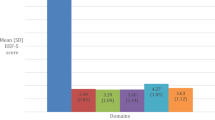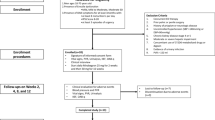Abstract
The objective of this study was to examine the association between sexual activities, problems and satisfaction, and ED and PDE5 inhibitor (PDE5i) use. A nationally representative sample of men (n=2612) aged 51–87 years from the English Longitudinal Study of Ageing completed an in-depth Sexual Relationships and Activities Questionnaire. Associations between ED and/or PDE5i use and sexual outcomes were explored using logistic regression models adjusted for age, health and lifestyle factors. PDE5i use in the preceding 3 months was reported by a total of 191 (7%) men, whereas 542 (21%) reported ED but no PDE5i use (untreated ED). Compared with men without ED, PDE5i users were more likely to be sexually active and report more frequent sexual intercourse. Men with untreated ED reported the lowest frequency of sexual activities. Compared with men without ED, both PDE5i users and those with untreated ED were more likely to report being concerned about their level of sexual desire, frequency of sexual activities, erectile function, waking erections and orgasmic experience. PDE5i users were also more concerned about and dissatisfied with their overall sex life than men without ED. This population-based study shows that while PDE5i use is associated with improved sexual functioning, this is not equally reflected in decreased levels of concern and dissatisfaction with their overall sexual health. Clinicians should be aware of this disparity between functional gains and continuing sexual concerns and dissatisfaction, and, where appropriate, offer psychosexual counselling as an adjunct to PDE5i medication.
This is a preview of subscription content, access via your institution
Access options
Subscribe to this journal
Receive 8 print issues and online access
$259.00 per year
only $32.38 per issue
Buy this article
- Purchase on Springer Link
- Instant access to full article PDF
Prices may be subject to local taxes which are calculated during checkout
Similar content being viewed by others
References
Yuan J, Zhang R, Yang Z, Lee J, Liu Y, Tian J et al. Comparative effectiveness and safety of oral phosphodiesterase type 5 inhibitors for erectile dysfunction: a systematic review and network meta-analysis. Eur Urol 2013; 63: 902–912.
ONS. Office for National Statistics http://www.ons.gov.uk/ons/rel/npp/national-population-projections/2010-based-projections/index.html. 2011. Accessed on 5 March 2014.
Howel D . Trends in the prevalence of obesity and overweight in English adults by age and birth cohort, 1991-2006. Public Health Nutr 2011; 14: 27–33.
Federation ID. Diabetes Atlas, 5th edn www.diabetesatlas.org. 2011. Accessed on 12 June 2014.
Steptoe A, Breeze E, Banks J, Nazroo J . Cohort Profile: the English Longitudinal Study of Ageing. Int J Epidemiol 2013; 42: 1640–1648.
Mitchell KR, Ploubidis GB, Datta J, Wellings K . The Natsal-SF: a validated measure of sexual function for use in community surveys. Eur J Epidemiol 2012; 27: 409–418.
O'Connor DB, Corona G, Forti G, Tajar A, Lee DM, Finn JD et al. Assessment of sexual health in aging men in Europe: development and validation of the European Male Ageing Study sexual function questionnaire. J Sex Med 2008; 5: 1374–1385.
Waite LJ, Laumann EO, Das A, Schumm LP . Sexuality: measures of partnerships, practices, attitudes, and problems in the National Social Life, Health, and Aging Study. J Gerontol B Psychol Sci Soc Sci 2009; 64 (Suppl 1): i56–i66.
Suzman R . The National Social Life, Health, and Aging Project: an introduction. J Gerontol B Psychol Sci Soc Sci 2009; 64 (Suppl 1): i5–i11.
Mercer CH, Wellings K, Johnson AM . What's new about Natsal-3? Sex Transm Infect 2013; 90: 80–81.
Lee DM, Nazroo J, O'Connor DB, Blake M, Pendleton N . Sexual Health and Wellbeing Among Older Men and Women in England: Findings from the English Longitudinal Study of Ageing. Arch Sex Behav 2015 doi: 10.1007/s10508-014-0465-1.
Steffick DE . Documentation of Affective Functioning Measures in the Health and Retirement Study. Survey Research Center, University of Michigan, Ann Arbor, MI, 2000.
Shamloul R, Ghanem H . Erectile dysfunction. Lancet 2013; 381: 153–165.
Althof SE . Quality of life and erectile dysfunction. Urology 2002; 59: 803–810.
Latini DM, Penson DF, Colwell HH, Lubeck DP, Mehta SS, Henning JM et al. Psychological impact of erectile dysfunction: validation of a new health related quality of life measure for patients with erectile dysfunction. J Urol 2002; 168: 2086–2091.
Latini DM, Penson DF, Lubeck DP, Wallace KL, Henning JM, Lue TF . Longitudinal differences in disease specific quality of life in men with erectile dysfunction: results from the Exploratory Comprehensive Evaluation of Erectile Dysfunction study. J Urol 2003; 169: 1437–1442.
Clark NG, Fox KM, Grandy S, Group SS . Symptoms of diabetes and their association with the risk and presence of diabetes: findings from the Study to Help Improve Early evaluation and management of risk factors Leading to Diabetes (SHIELD). Diabetes Care 2007; 30: 2868–2873.
Inman BA, Sauver JL, Jacobson DJ, McGree ME, Nehra A, Lieber MM et al. A population-based, longitudinal study of erectile dysfunction and future coronary artery disease. Mayo Clin Proc 2009; 84: 108–113.
Ponholzer A, Gutjahr G, Temml C, Madersbacher S . Is erectile dysfunction a predictor of cardiovascular events or stroke? A prospective study using a validated questionnaire. Int J Impot Res 2010; 22: 25–29.
Quek KF, Sallam AA, Ng CH, Chua CB . Prevalence of sexual problems and its association with social, psychological and physical factors among men in a Malaysian population: a cross-sectional study. J Sex Med 2008; 5: 70–76.
Thompson IM, Tangen CM, Goodman PJ, Probstfield JL, Moinpour CM, Coltman CA . Erectile dysfunction and subsequent cardiovascular disease. JAMA 2005; 294: 2996–3002.
Lewis RW, Fugl-Meyer KS, Corona G, Hayes RD, Laumann EO, Moreira ED Jr . et al. Definitions/epidemiology/risk factors for sexual dysfunction. J Sex Med 2010; 7: 1598–1607.
Riley AJ, Steiner JA, Cooper R, McPherson CK . The Prevalence of Sexual Dysfunction in Male and Female Hypertensive Patients. Sex Marital Ther 1987; 2: 131–138.
McMahon CG, Abdo C, Incrocci L, Perelman M, Rowland D, Waldinger M et al. Disorders of orgasm and ejaculation in men. J Sex Med 2004; 1: 58–65.
Matic H, McCabe MP . The impact of the use of PDE5 inhibitors for erectile dysfunction on the lives of Australian men. Int J Impot Res 2007; 19: 418–423.
Levine SB . Erectile dysfunction: why drug therapy isn't always enough. Cleve Clin J Med 2003; 70: 241–246.
Gott M, Hinchliff S . Barriers to seeking treatment for sexual problems in primary care: a qualitative study with older people. Fam Pract 2003; 20: 690–695.
Gott M, Hinchliff S . Galena E. General practitioner attitudes to discussing sexual health issues with older people. Soc Sci Med 2004; 58: 2093–2103.
Barnett ZL, Robleda-Gomez S, Pachana NA . Viagra: the little blue pill with big repercussions. Aging Ment Health 2012; 16: 84–88.
Aubin S, Heiman JR, Berger RE, Murallo AV, Yung-Wen L . Comparing Sildenafil alone vs Sildenafil plus brief couple sex therapy on erectile dysfunction and couples' sexual and marital quality of life: a pilot study. J Sex Marital Ther 2009; 35: 122–143.
Fenton KA, Johnson AM, McManus S, Erens B . Measuring sexual behaviour: methodological challenges in survey research. Sex Transm Infect 2001; 77: 84–92.
Acknowledgements
We thank the study participants. DML is a Research into Ageing Fellow. This study was funded by the National Institute on Aging (grants 2RO1AG7644-01A1 and 2RO1AG017644) and a consortium of UK Government departments coordinated by the Office for National Statistics. JN and NP were supported by the fRaill project (grant MRC G1001375/1) as part of the cross-research council Life Long Health and Wellbeing Programme.
Author information
Authors and Affiliations
Corresponding author
Ethics declarations
Competing interests
The authors declare no conflict of interest.
Rights and permissions
About this article
Cite this article
Lee, D., Nazroo, J. & Pendleton, N. Erectile dysfunction and phosphodiesterase type 5 inhibitor use: associations with sexual activities, function and satisfaction in a population sample of older men. Int J Impot Res 27, 146–151 (2015). https://doi.org/10.1038/ijir.2015.4
Received:
Revised:
Accepted:
Published:
Issue Date:
DOI: https://doi.org/10.1038/ijir.2015.4
This article is cited by
-
Efficacy of low-intensity shockwave therapy with different tadalafil regimens in patients with PDE5 inhibitor-resistant erectile dysfunction: a retrospective cohort study
International Urology and Nephrology (2023)
-
Perceived Importance and Enjoyment of Sexuality in Late Midlife: Cohort Differences in the Longitudinal Aging Study Amsterdam (LASA)
Sexuality Research and Social Policy (2021)
-
Erektile Dysfunktion und das "Stanley-Beamish-Problem"
Uro-News (2021)
-
Treatment Approaches to Sexual Dysfunction in Late Life
Current Treatment Options in Psychiatry (2018)
-
Declines in Sexual Frequency among American Adults, 1989–2014
Archives of Sexual Behavior (2017)



